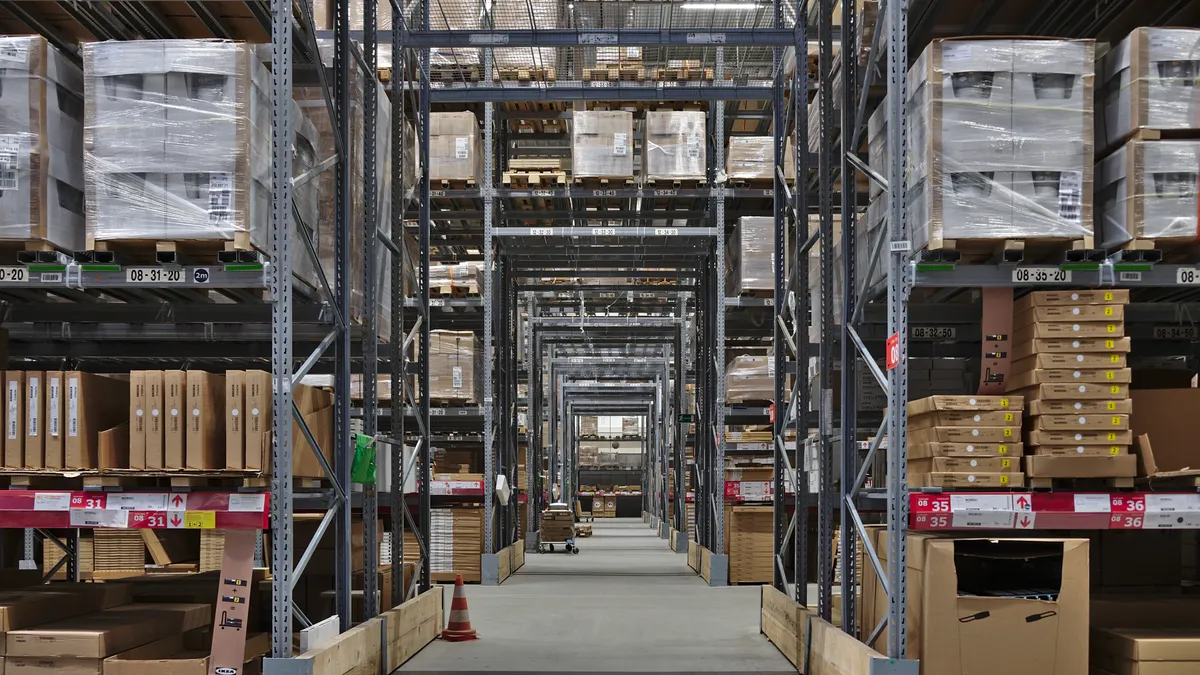Dive Brief:
- The total business inventory-to-sales ratio hit its lowest point since 2014 in August, according to the latest figures from the U.S. Census Bureau, released last month.
- The figure dipped the lowest for retail, which saw its inventory-to-sales figure drop to 1.23 in August. Wholesalers and manufacturers kept inventories slightly more elevated, with ratios of 1.31 and 1.43, respectively.
- Private, non-farm inventories fell by nearly $4 billion in Q3 after falling nearly $298 billion in Q2, according to the most recent GDP release from the Bureau of Economic Analysis.

Dive Insight:
Retail inventories have been on a wild ride through the course of the coronavirus pandemic. Inventories bulged when retailers shut their doors and sales stopped as a result of lockdown orders. The retail inventory-to-sales figure hit 1.68 in April, which is the highest its been since 1996. Four months later and retailers found themselves in the opposite situation.
Total retail and foodservice sales jumped nearly 24% from April to May as movement restrictions loosened, retailers opened their doors and inventory flowed successfully from store to consumer. Now, retailers are working to refill backrooms as inventories have been whittled away by strong consumer spending.
"The pandemic accelerated the recovery in the freight cycle," said Tim Denoyer, ACT Research vice president and senior analyst. "What's going on is a big restock."
Retailers have been open about their challenges with inventory management through this roller coaster ride.
"As we reopened, we weren't able to optimize the inventory flow back to our stores like we would in a normal environment," TJX CEO Ernie Herrman told analysts in mid-August. "In addition to delays ramping our business back up, government reopening guidance caused some misalignment in the timing of when we reopened distribution centers and stores, particularly in Canada."
Herrman said the company also experienced delays from vendors and transportation providers as they restarted their businesses.
"We have put strategies in place to mitigate some of these inventory delays going forward," he said, not expanding on what those strategies were.
The retailer did make sure to highlight that the inventory issues weren't the result of the merchandise being absent on the marketplace, but rather delays and higher-than-expected sales.
There are signs that the restocking efforts by the retail sector is well underway. U.S. ocean imports increased 15% YoY in September. The surge in imports has led to some supply chain bottlenecks, but it does suggest that inventory is working its way to retailers as they prepare for the holiday season.
"Part of this surge was fueled by restocking after retail sales rebounded this summer and part could be making sure there aren't shortages if we see panic buying again," National Retail Federation Vice President for Supply Chain and Customs Policy Jonathan Gold said in a statement. "The economic challenges of the pandemic aren’t over yet, but this clearly shows how an industry that has been under stress is fighting back in a positive way. Retailers don’t import merchandise they don’t think they can sell, so this is a good sign for the holiday season."
Retailers have been importing "record amounts" of merchandise, Gold said in a separate emailed statement, and he expects inventories to return to normal levels as products move through the supply chain.
This story was first published in our weekly newsletter, Supply Chain Dive: Operations. Sign up here.














